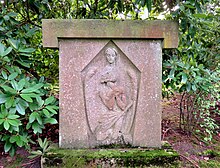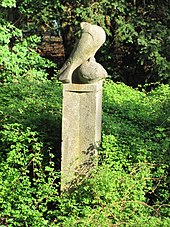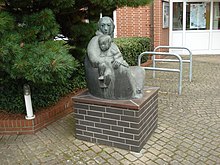Martin Irwahn

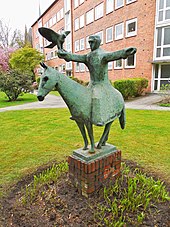

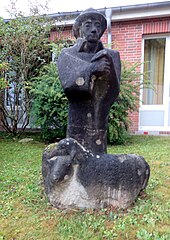

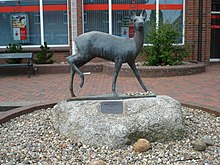
August Julius Martin Irwahn (born February 18, 1898 in Hamburg ; † July 11, 1981 in Eddelsen near Hittfeld , Seevetal ) was a German painter and sculptor of the lost generation .
Life
Martin Irwahn was born on February 18, 1898 as the son of the businessman Johannes Wilhelm Heinrich Irwahn (1868-1948) and his wife Amanda Jacobine Emma Irwahn (* 1871), née Raab , in their apartment at Spaldingstrasse 80 in Hamburg-Hammerbrook . His mother was the sister of the porcelain painter and politician Friedrich Raab , who at the time belonged to the Hamburg citizenship . His father Johannes Irwahn convened the founding meeting of the DHV in 1893 and was its association chairman from 1893 to 1896. His grandfather Johannes Irwahn was a clergyman in Hamburg-Rothenburgsort . Martin Irwahn grew up with his siblings Fritz (* 1900) and Gertrud. The graves of the parents, the brother and his wife are to the right of the grave of Friedrich Raab in the Ohlsdorf cemetery in Hamburg at grid square B 14 (southeast of chapel 4 on the outer fence).
When Martin Irwahn was three years old, his left hand was mutilated after an accident, but he was later able to hold a chisel with it. He was operated on several times from 1910 onwards because of an ear tuberculosis . Since his parents rejected his wish to become an artist, he moved out of their homes and into a water tower at Waldstrasse 37. 1911–1917 he completed his training as a sculptor at the Hamburg School of Applied Arts with Johann Michael Bossard and Richard Luksch with very good grades. He then studied at the Academy of Fine Arts in Dresden with Georg Wrba .
From 1920 he worked as a freelance artist in Hamburg, where he became a member of the Hamburg Art Association . This was followed by a joint painting of luxury cardboard boxes for chocolates, among others in the Armbruster company of Max Armbruster in Bergedorf with Willem Grimm , the painter Gertrud Müller-Teut (also Trude Teut (born February 11, 1895 in Hamburg; † June 14, 1986 ibid) , Daughter of the Low German writer Heinrich Teut) as well as the painter and later restorer in the monastery Wienhausen Gertrud ( Trulle ) Brinckmann (born July 3, 1902 in Bergedorf; † October 6, 1993 in Hamburg), the daughter of the museum director of the Museum of Art and Industry Hamburg Justus Brinckmann and his third wife, the painter Henriette Hahn-Brinckmann . In 1926 he married Gertrud Brinckmann. The son Hans-Martin Irwahn was born on January 15, 1927. 1928 Martin and Gertrud Irwahn coated with son of mountains village in an old Kate in Voss bog at Geesthacht . Hans Martin Ruwoldt , Karl Kluth and Willem Grimm studied the animals of his local livestock . Even Herbert Spangenberg operation there studies for his cage pictures .
After the seizure of power of the Nazis Irwahn could stylistically not develop freely, as this works otherwise than degenerate art would be declared. He got pressures and job restrictions. The daughter Gesa Irwahn was born on December 7, 1933 and the second son Heinrich Justus ( Heiner ) Irwahn on August 13, 1935 . From 1936 Martin Irwahn is listed in the Hamburg address book with the address Schwarze Straße 1 in Hamburg-Hamm . In the Ohlendorffhaus , which had this address, the city of Hamburg had been providing artists with studios with living space for a small rent since 1932. The Ohlendorffhaus was a neo-renaissance style palace that Heinrich Ohlendorff had built from 1874 to 1875 by the architect Martin Haller . Martin Irwahn had a studio on the first floor. In the same year Gertrud Irwahn took over the tasks of the caretaker in Ohlendorffhaus and Martin Irwahn created in order, along with building officer Hans Meding and Ludwig Kunstmann at the cemetery Ohlsdorf the honorary tomb for the fallen soldiers of the movement . Between Irwahn and the sculptor Alfred Wittich, in his function as art warden for the Hamburg Senate , there were differences over the crypt of honor . Then Irwahn stayed temporarily in Berlin . From 1937 Gertrud Irwahn is listed in the Hamburg address book with the addition Spritzmalerei and the address Lindenstrasse 19 in Hamburg-St. Georg , from 1940 with the address Große Theaterstraße 44/45 in Hamburg-Neustadt . In 1940, Martin Irwahn took part in a training course for large- scale sculpture from Johann Michael Bossard at the Hanseatic University of Fine Arts . As a template for animal sculptures, he often made drawings in the Hagenbeck Zoo .
During the Second World War , Hamburg-Hamm was almost completely destroyed in Allied air raids as part of Operation Gomorrah in July 1943. The Ohlendorffhaus was also affected. All of Irwahn's works stored there were destroyed, including the works of Paul Bollmann , Eduard Hopf and Emil Rasmus Jensen . Irwahn was an air raid guard for the Ohlendorffhaus . By letting around 400 people in the air raid shelter, which was designed for 50 people , he saved the lives of many people. Irwahn, his pupil, painter and sculptor Ruth Godbersen (born February 17, 1921 in Kiel), Karl Kluth's wife Hannah and Emil Rasmus Jensen then ran towards Horner Kreisel and later found accommodation with Gertrud Irwahn. Irwahn fled to Dagebüll with his family and Ruth Godbersen , but soon returned and separated from Gertrud in order to live with Ruth Godbersen on Grosse Theaterstrasse .
After the body of the painter, graphic artist and professor at the Hanseatic University of Fine Arts Hugo Meier-Thur, who was arrested for his statements against the Nazi regime and the subsequent denunciation and murdered in the Fuhlsbüttel concentration camp , was handed over to his relatives for burial the painter and sculptor Emma Gertrud Eckermann wanted to make a death mask with Martin Irwahn . On the corpse, they were able to find traces of severe abuse and a blue head, which suggested that Meier-Thur had been suffocated after the abuse.
In 1945, Martin Irwahn and Richard Steffen, among others, founded the Hamburger Gruppe 1945 artist group , which Ruth Godbersen also belonged to. In 1945 he was co-founder and member No. 1 of the later Professional Association of Visual Artists Hamburg , of which he was 1st chairman until 1949. He was involved in the introduction of the two percent clause for art in buildings . In 1946 he was one of the co-founders of the workshop community and school for all arts, Der Baukreis . He married Ruth Godbersen, who gave birth to his son Godber, and traveled to London in 1947 for a visit. Due to differences of opinion, Martin and Ruth Irwahn, among others, left the Hamburg group in 1945 . In 1949 he gave up his studio at Grosse Theaterstrasse 45, but is still listed there in the Hamburg address book from 1950.
For a year he occupied the vacant manor house on Gut Eddelsen in Eddelsen, where the painter Leopold von Kalckreuth once lived and where the painter Leopold von Kalckreuth once lived and died in December 1928, with other artists, such as the painter Paul Schmehrsal (1902–1981) . The Good Eddelsen inherited Kalckreuth of Hamburg with determining where to create a retirement home for destitute artists, but took it after a long vacancy in the Second World War as an alternative hospital for Harburg hospital and sold it after the war to the oil company Shell , which there set up a conference and training center.
After the squatting ended, Irwahn lived in the Eddelsen railroad man's house for three years and then moved into a house on a hillside property in Eddelsen. In 1960 he was awarded the Edwin Scharff Prize of the City of Hamburg, as was the painter and graphic artist Tom Hops . Later Irwahn became a member of the artists' association Seevetaler Künstler 74 , which was founded in 1974 and has not exhibited since 2007. Another member is the sculptor and painter Sabine von Diest-Brackenhausen .
Martin Irwahn was buried in the Hittfeld cemetery. The grave where his wife Ruth, who had died before him, and their son Godber are buried, slowly fell into disrepair. A sculpture Irwahns made of concrete and structural steel, which represented a sitting girl, was destroyed by the weather. A simple concrete slab and a sign bearing his name and his dates of birth and death have only indicated his grave since then. In 2017 the Heimatverein Hittfeld exchanged the concrete slab for a granite boulder donated by Otto Dörner . In addition, two donated, new signs made of weatherproof stainless steel were made, which were attached to the boulder together with the name plate. The top, new sign reads “Seevetaler Künstler” and underneath it the year of foundation “1974”, then the old sign follows, and under this there is a small sign with the inscription “Heimatverein Hittfeld 2017”. The Otto Dörner company , which bought Irwahn's house and property around 2011, also donated a boulder in 2015 on which a bronze Irwahns deer from 1970 was mounted, which was also set up in Hittfeld.
Exhibitions (selection)
Solo exhibitions
- 1936: With Willem Grimm and Will Spanier (1894–1957), Kunstverein in Hamburg
- 1940: Spring exhibition , Griffelkunst-Vereinigung Hamburg-Langenhorn , Fritz Schumacher School , Hamburg-Langenhorn
- 1949: With Eduard Bargheer , Kunstverein in Hamburg
- 1980: With Detlef Birgfeld (* 1937) and Eylert Spars (1903–1984), Kunsthaus Hamburg
Group exhibitions
- 1927: Exhibition of the Hamburg Art Association , Hamburger Kunsthalle
- 1940: German contemporary sculptors , Kunstverein in Hamburg
- 1941: Autumn exhibition of Hamburg artists in the Hamburger Kunsthalle , organized by the Kunstverein in Hamburg - plaster sculpture: polar bear
- 1942: North German watercolors and small sculptures , Hamburger Kunsthalle
- 1946: The Hamburg group's first exhibition in 1945 in the Hamburg painters ' rooms , Alsterufer 11, Hamburg-Rotherbaum
- 1949: 2nd German Art Exhibition , Stadthalle Nordplatz, Dresden - Albertstadt
- 1949: Kunstverein in Hamburg
- 1951: Sculpture and sculptural drawings , Kunstverein in Hamburg
- 1965: Ten years of the Edwin Scharff Prize , Kunsthaus Hamburg
- 1972: Sculptor in Hamburg , Kunsthaus Hamburg
- From the 1970s: exhibitions with the artist group Seevetaler Künstler 74 in Seevetal
- 2017: The art is public , Hamburger Kunsthalle - bronze sculpture: courting herons
Works (selection)
- 1920: Angel with gravedigger , gravestone relief with inscriptions (“V.” stands for “ Vers ”), top left “ MATTH. 5. V. 8 "(" Blessed are the pure in heart; for they will see God. ") And at the top right" PSALM 90. V. 10 "(" The time of our life is seventy years, when it comes up, eighty The best thing about it is hardship and fate, it goes by quickly, we fly there. ”), Grave Vorg Huminius, at the Riedemann mausoleum, across from Chapel 8, Ohlsdorf cemetery , Hamburg-Ohlsdorf
- 1936: Crypt of honor for the fallen of the movement , Ohlsdorf cemetery, Hamburg-Ohlsdorf, together with building supervisors Hans Meding and Ludwig Kunstmann - leveled in 1946
- 1937: Design of two busts of Paul von Hindenburg and Adolf Hitler , made from yellowish marble by the stonemason company Thiele & Co. , on behalf of the Greater Hamburg Guilds for the vestibule of the Hamburg Chamber of Crafts
- 1949: Herons courting , bronze, Hamburger Kunsthalle
- 1950: Pigeons , shell limestone , Hamburg City Park , Hamburg-Winterhude
- 1951: Pair of children reading , Muschelkalk, Niendorf district school, Paul-Sorge-Strasse 133–135, Hamburg-Niendorf
- 1951: Dancing girls , ceramics , on a former fountain in the inner courtyard, Naumannplatz ( SAGA ), Hamburg-Dulsberg
- 1954: geese pair , bronze , height cm 85, School Lupinenweg (1981 closed), Lupinenweg 12, osdorf
- 1954: Falconer on horseback , bronze, cast by Schmäke art foundry , Düsseldorf. Schürbeker Strasse 10b, Hamburg-Uhlenhorst
- 1955: Boy with a dog , bronze, Richardstrasse 44, Hamburg-Uhlenhorst
- 1958: Gazelle , bronze, Heim Averhoffstraße , Hamburg-Uhlenhorst
- 1959: Goldesel , Musäusstrasse School (today Iserbrook School ), Hamburg-Iserbrook
- 1959: Two otters , Stein, Schmachthäger Strasse 70 (SAGA), Hamburg-Steilshoop
- 1960: Foal , bronze, Schöneberger Strasse 19 (SAGA), Hamburg-Jenfeld
- 1960: Horse , bronze, school Weusthoffstraße 95 (today elementary school am Kiefernberg ), Hamburg-Heimfeld
- 1960: Mother and child , bronze, first at the Mörkenstrasse health department (demolished) in Hamburg-Altona-Altstadt , then at the Altona health department in Hamburg-Ottensen
- 1960: Foal , bronze, Korachstrasse , Hamburg-Lohbrügge
- 1965: Flamingos , bronze, Asklepios Westklinikum Hamburg , Hamburg-Rissen
- 1965: Shepherd , Stein, house 6, in the courtyard of ward 6a of the Asklepios Klinik Nord , location Ochsenzoll , Hamburg-Langenhorn
- 1966: Reading boy , bronze, Ladenbeker Furtweg 14, Hamburg-Lohbrügge
- 1966: Foal group , Stübenhofer Weg School , Hamburg-Wilhelmsburg
- 1968: Rider with two horses , bronze, cast by Wilhelm Füssel, Berlin-Charlottenburg . Wagrierweg 31, Hamburg-Niendorf
- 1970: deer , bronze. The sculpture stood in the artist's garden in Eddelsen during his lifetime. Other owners were the son Godber and then his heir. This left it to the Eddelsen Citizens' Association , which together with the Hittfeld Heimatverein had it set up in front of the Sparkasse Harburg-Buxtehude branch at Kirchstrasse 19 in Hittfeld in 2015 .
- 1971: Three cranes , bronze, Ladenbeker Weg 22, Hamburg-Lohbrügge
- 1979: Mother and child , bronze, Kirchstrasse 11, in front of the town hall of the Seevetal community in Hittfeld
- 19 ??: Loser of files , sculpture, DAG House (DHV), today Brahms Kontor , Hamburg-Neustadt
- 19 ??: Cranes (probably by Martin Irwahn), plaster and metal, unsigned. Until November 2013 the sculpture stood on the veranda of Irwahn's former house in Eddelsen, then in the Karoxbostel watermill , Verein Wassermühle Karoxbostel , Karoxbostel
literature
- Irwahn, Martin . In: Hans Vollmer (Hrsg.): General Lexicon of Fine Artists of the XX. Century. tape 2 : E-J . EA Seemann, Leipzig 1955, p. 571 .
- Martin Irwahn. In: Christian Otto Frenzel: Art in architecture in Hamburg 1947–1958. On behalf of and in cooperation with the Hamburg building authority. Axel Springer publishing house in Hamburg. Hammerich & Lesser, Hamburg 1959, pp. 66, 67, 133.
- Irwahn, Martin. In: Heinz Spielmann : Sculptor in Hamburg 1900–1972 , Professional Association of Visual Artists Hamburg (ed.), Hans Christians Verlag, Hamburg 1972, ISBN 978-3-7672-0194-1 (not paginated ).
- Irwahn, Martin. In: Volker Detlef Heydorn : Painter in Hamburg. Volume 2: 1945-1966. Professional Association of Visual Artists, Hamburg (ed.). Hans Christians Verlag, Hamburg 1974, ISBN 3-7672-0277-8 , pp. 19-21, 25.
- Martin Irwahn. In: Heinz Zabel : Plastic Art in Hamburg - Sculptures and sculptures in public spaces , 2nd edition, Dialog-Verlag, Reinbek 1987, ISBN 3-923707-15-0 , pp. 34, 42, 49, 56, 58, 60 , 68, 69, 72, 80, 83, 101.
- Volker Plagemann (ed.): Art in public space. A guide through the city of Hamburg . Junius Verlag , Hamburg 1997, ISBN 3-88506-275-5 , pp. 97, 116, 118, 119.
- Maike Bruhns : Art in Crisis. Volume 1: Hamburg Art in the “Third Reich”. Dölling and Galitz, Munich / Hamburg 2001, ISBN 3-933374-94-4 , pp. 56, 69, 98, 112, 132, 135, 137, 153, 155, 164, 295, 415, 421, 442, 466, 475, 477, 484-486, 504, 580, 596, 634, 596.
- Maike Bruhns: Art in Crisis. Volume 2: Artist Lexicon Hamburg 1933–1945. Dölling and Galitz, Munich / Hamburg 2001, ISBN 3-933374-95-2 , pp. 60, 76, 84, 124, 155, 164, 213-215, 272, 288, 290, 327, 336, 338, 365, 367, 371, 400, 401.
- Friederike Weimar, Ute Janssen, SAGA GWG (eds.): Art in the quarter. Hamburg's major landlord promotes culture in the districts. Examples from eight decades , Hamburg 2008, pp. 72–73, 76–77, 80–81 ( PDF file ).
- Uta Schoop: Arnold Fiedler (1900–1985) - An artist's monograph. Dissertation. 2011, pp. 16, 263-264, 284-285, 289, 298, 318, 338, 342, 373, 434 ( PDF file ).
- Maike Bruhns: Irwahn, Martin. In: The new rump. Lexicon of the visual artists of Hamburg . Ed .: Rump family. Revised new edition of Ernst Rump's lexicon ; supplemented and revised by Maike Bruhns, Wachholtz, Neumünster 2013, ISBN 978-3-529-02792-5 , pp. 213-214.
- Heike Vosberg: Mill asylum for cranes. In: Winsener Anzeiger , November 8, 2013 ( digitized version )
- Citizenship of the Free and Hanseatic City of Hamburg : Works of art in public space , Hamburg, August 14, 2018, pp. 3, 4, 12, 15, 20, 26, 31, 32 ( PDF file ).
Web links
- Martin Irwahn at sh-kunst.de
Individual evidence
- ↑ Entry 397 from February 23, 1898 in the birth register (August Julius Martin Irwahn), Hamburg 01, 1898 Volume 01 (viewed at ancestry.de ). A subsequent stamp on the certificate indicates the date and place of death Seevetal .
- ↑ Iris Hamel: Völkischer Verband and national trade union , pp. 44, 45 (footnotes 101 and 102)
- ^ Gertrud Müller-Teut at the Stahl auction house
- ↑ Data from Gertrud (Trulle) Brickmann and the children on woydt.be
- ↑ a b c d e f g h i Maike Bruhns : Irwahn, Martin. In: The new rump. Lexicon of the visual artists of Hamburg . Ed .: Rump family. Revised new edition of Ernst Rump's lexicon ; supplemented and revised by Maike Bruhns, Wachholtz, Neumünster 2013, pp. 213–214
- ↑ Irwahn, Martin in the Hamburg address of 1943
- ↑ Artist collective in the Palais. In: Hamburger Anzeiger , June 15, 1932, p. 2
- ↑ Uta Schoop: Arnold Fiedler (1900–1985) - An artist monograph. Dissertation. 2011, pp. 263-264, 284-285
- ↑ Arne Jensen: High talent among short stature. The sculptor Emil Rasmus Jensen. In: ADS-Grenzfriedensbund (Ed.): Journal for German-Danish Dialog , Annual Volume 2017, p. 76
- ↑ Maike Bruhns gives the year 1931, regarding Irwahn's entry. In: Art in the Crisis , Volume 2, Dölling and Galitz, Munich / Hamburg 2001, pp. 213–215 and Der neue Rump. Lexicon of the visual artists of Hamburg . Ed .: Rump family. Revised new edition of Ernst Rump's lexicon ; supplemented and revised by Maike Bruhns, Wachholtz, Neumünster 2013, p. 213
- ↑ Maike Bruhns: Art in the Crisis , Volume 2, Dölling and Galitz, Munich / Hamburg 2001, p. 215
- ^ Crypt of honor for the fallen of the movement , explanation of terms on hamburg.de
- ↑ Arne Jensen: High talent among short stature. The sculptor Emil Rasmus Jensen. In: ADS-Grenzfriedensbund (Ed.): Journal for German-Danish Dialog , Annual Volume 2017, p. 79
- ^ Hugo Meier-Thur. In: Memorial book for the Nazi victims from Wuppertal on gedenkbuch-Wuppertal.de
- ^ Volker Detlef Heydorn : Painter in Hamburg. Volume 2: 1945-1966. Professional Association of Visual Artists, Hamburg (ed.). Hans Christians Verlag, Hamburg 1974, pp. 19, 20
- ^ Volker Detlef Heydorn: Painter in Hamburg. Volume 2: 1945-1966. Professional Association of Visual Artists, Hamburg (ed.). Hans Christians Verlag, Hamburg 1974, p. 20
- ↑ Leaflet Bahnhofsrunde Hittfeld (PDF file) on seevetal.de
- ^ Winner of the Edwin Scharff Prize on hamburg.de
- ^ Lena Thiele: Late honor for an artist from Hittfeld. In: Hamburger Abendblatt , September 29, 2017
- ↑ From February 29, shows ... In: Hamburger Anzeiger , February 29, 1936, p. 9
- ↑ Lieselotte Kruglewsky-Anders (Ed.): 50 Years of the Griffelkunst Association - Art Education in the Spirit of Lichtwark . Edition Griffelkunst Hamburg, Hamburg 1977, p. 181
- ↑ Exhibitions on kunsthaushamburg.de
- ↑ Exhibition catalog , 1941, p. 9
- ↑ Hugo Sieker : High profit through voluntary restriction. In: Hamburger Anzeiger , November 15, 1941, p. 2
- ↑ Martin Irwahn on artist-info.con
- ↑ Figure courting herons
- ↑ The exhibition on hamburger-kunsthalle.de
- ↑ Matthew 5 on bibleserver.de
- ↑ Psalm 90 on bibleserver.de
- ↑ Handover of the commercial building. In: Hamburger Anzeiger , November 30, 1937, p. 5
- ↑ 40,000 craftsmen march on Holstenwall. In: Altonaer Nachrichten , December 4, 1934, p. 6
- ↑ Image on kulturkarte.de (5th photo)
- ↑ Figure. In: Wandsbek informative. The Wandsbecker Bote , April 2012, p. 24
- ↑ Photo mother and child in Altona ( Getty Images )
- ↑ Mention of the Altona health and environment office on heimatverein-hittfeld.de
- ^ A b Christiane Tauer: A deer for the Hittfelder Kirchstrasse. In: Hamburger Abendblatt , December 11, 2015
- ↑ Heike Vosberg: Mill asylum for cranes. In: Winsener Anzeiger ( Facebook ), November 7, 2013 (photo of the sculpture)
| personal data | |
|---|---|
| SURNAME | Irwahn, Martin |
| ALTERNATIVE NAMES | Irwahn, August Julius Martin |
| BRIEF DESCRIPTION | German painter and sculptor |
| DATE OF BIRTH | February 18, 1898 |
| PLACE OF BIRTH | Hamburg |
| DATE OF DEATH | July 11, 1981 |
| Place of death | Eddelsen, Seevetal |
